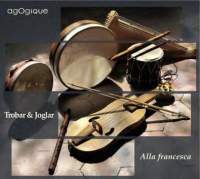Texte paru dans: / Appeared in: Code-barres / Barcode : 3700675500177 |
|
|
|
|
|
Reviewer: Barry
Brenesal The liner notes to Trobar & Joglar claim it raises “a fundamental issue” about “the transmission of the medieval lyric” by “jongleurs alongside the troubadours and trouvères.” But we already know that jongleurs were originally regarded as low-class entertainers, while troubadours and trouvères, composer-poets, were initially upper-class folk; and that by the time 100 years had passed, the distinctions had become blurred. The liner notes call Guillem Augier Novella a jongleur, for example, as does Elizabeth Aubrey in The Music of the Troubadours, but she writes this in her chapter devoted exclusively to troubadour bios. And Elaine Graham-Leigh, in her work on Occitan nobility and the Albigensian Crusade, describes him as a troubadour composing in certain poetic forms after the manner of jongleurs. All of which is to say that whatever issue the liner notes raise, nothing is settled, and nothing new is brought to the table. Instead, we have one of Alla Francesca’s typically attractive programs mixing nine troubadour and trouvère songs with five instrumental pieces—two anonymous works from Aquitaine, and three improvisations in the style of the times and its performers. Four musicians are involved in the album this time, with Pierre Hamon back after having taken a break from their Thibaut de Champagne: Le chansonnier du roi release (Aeon 1221). He’s joined by co-leader Brigitte Lesne, Vivabiancaluna Biffi, and Carlo Rizzo. The two women provide the vocals. All four are proficient instrumentalists, heard here on Medieval harp, flutes, cornemuse (small, rustic bagpipes), viele, and a mix of percussion. One particular selection caught my eye: Beatritz de Dia’s Ab joi et ab joven m’apais. In fact, it was one of the reasons I wanted to review this release, seeing as how only one song of hers, A chantar m’er de so qu’eu no volria, exists with both poem and music intact. Effectively, Ab joi would thus increase her known “complete” works by 100 percent—except that it’s again just the words, set here to an anonymous Aquitainean melody of similar metrical values. The odd thing is that the liner notes refer to this as a contrafactum, but in every source I’ve read, the term refers exclusively to new verses set to older melodies, not the reverse. This isn’t to denigrate the worth of it, nor of the other quasi-conftrafacta on this disc: the descort Eras quan vei verdeiar by Raimbaut de Vaquieras, set to a melody roughly three quarters of a century later by Guiraut Riquier; and the anonymous Chanson de malmariée, set to music by Berenguer de Palou. If this popularizes more excellent poetry and music, all the better. But identifying any of this as the work of a single individual is unintentionally misleading. The poetic structures All Francesca chooses present a range of those employed during the period, and before the rise of the formes fixes. From a modern perspective three are the most interesting due to their theatrical immediacy. The tenso, Bona donna, tan vos ai fin conatge is a debate of love between a noble lady who spurns her lover, and one on a lower social rung (but presumably also noble, as was common in France at the time) who advocates him. There are also two descorts—the discord in the term lying in the mental state of the poet-as-actor, turned irrational by love of another. The performances are what you’d expect if you’ve heard Alla Francesca before, as the group’s approach to this music and its sound has remained relatively consistent since its founding in 1990. The songs are instrumentally accompanied, with the singers emoting lightly while focusing on musical values. Brigette Lesne’s voice has deepened and darkened over the years, which forms an effective contrast with Biffi’s mezzo. The instruments are usually deployed sparingly in tonic reiteration on the monophonic pieces, though on a few occasions (notably in Ab joi) one will function in near-canon, trailing the theme for a while at some distance after the voice. There’s a good mix of freely phrased content and strictly rhythmic numbers, the latter usually more energetic dances; and this, with the textural variety, keeps away any hint of aural fatigue. Original texts are supplied in Occitan and Old French, alongside modern French and English. Blessedly, there is no attempt made to reproduce the original complex rhyme schemes in the English. In short, heartedly recommended for the music, and the performances. | |
|
|
|
|
|
|
|
Cliquez l'un ou l'autre
bouton pour découvrir bien d'autres critiques de CD |
|




